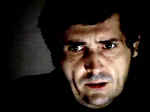A friend of mine from high school was in semi-confessional mode last week - not an abnormal reaction to a fourth pint of Guinness - and claimed that one of the things that most turned him off to the Catholic faith as a boy (leading to his total disenfranchisement as an adult) was the abundance of garish images scattered about his grandmother's house. How any of that scary stuff could motivate one to devotion and Christian charity still puzzles him. Apparently, St.Agnes' fluttering eyelids, slashed throat and lamb-in-arms are, to this day, the principal deterrant to his return to the Church.
If you have an Italian or a Mexican woman in your family tree, you know the artwork.
 St.Sebastian tied to a pillar with countless arrows obliquely piercing his body as he stares heavenward.
St.Sebastian tied to a pillar with countless arrows obliquely piercing his body as he stares heavenward.St.Christopher gasping for breath as a deceptively heavy Christ child robed in white, placidly perched on the drowning saint's shoulder raises his tiny hand in regal gesture.
St.George, a paleo-christian Lone Ranger mounted on a white stallion, skewers the fiery dragon, the hellish serpent, the infernal worm, the inflammable winged maggot.
St.Lawrence, patron of cooks, kneeling beside the pit of smouldering embers, dressed in his red dalmatic, palm sprig clenched to his chest yearning eyes cast beyond this world...
You get the idea.
Is it any wonder Hollywood has always found abundant material in Catholic tradition for its supernatural spook flicks? Just add a little more gore, contort that angelical visage a smidge and fill that gloomy church with candles, incense and otherworldly whispers and... wallah! A playroom worthy of Damien, Carrie and Emily Rose.
Imagery is key to Catholicism. We do not just profess our faith. We see it, we touch it, we hear it, we smell it, we taste it. We dress up and dramatize it on Christmas Eve and Good Friday. We make statues of our saints and use water, wine, bread and oil in our sacraments. We lay our hands on the sick, we wear roman collars and colorful vestments at Mass and one Wednesday a year we smear ashes on our forehead.
Can it go too far? Hmmm... As if 'too far' were still possible nowadays.
But yeah, it can. My mother has a plastic St.Philomena night-light that has creeped me out on more than one occasion. And that apparition-on-toast of the Virgin Mary? You tell me who the real loon is: the Ebay seller or the Ebay buyer.
But even the tacky, publicity-driven excesses drive home my point. Imagery is key.
Catholicism has always understood that body is the image, the expression of spirit. That the natural world is the chosen language of the spiritual world. That the reality we see is no less than a very elaborate invitation to the reality that escapes our senses.
Catholicism - and Christianity in general - originates from the Incarnation of the Word. The eternal, unfathomable knowledge that God has of Himself, the bottomless Truth that is the beginning and end of all we call real, the invisible Being that creates and sustains all being found, in the human form, the best way to make Himself known to the human world.
The choice of human imagery was His and all that is human finds new meaning therein.

Anyway, today - liturgical feast of the Sacred Heart - I was trying to work my way around the painting, framed in maroon velvet, that haunts my childhood recollections. A sallow, almost phantasmagoric Jesus with eyes that would make even a hardened hunter of baby seals feel pangs of compunction. He holds in his bony hand a heart, presumably his, crowned with thorns and a flame. It hurts and it burns.
I never really liked that painting, which was my grandmother's and surely her grandmother's before her. I am still not sure that I like it. But I am sure that my preaching on this day, in a parish named for the Sacred Heart, will not be better served by avoiding the imagery.
Like it or not, the image truly says it all.

